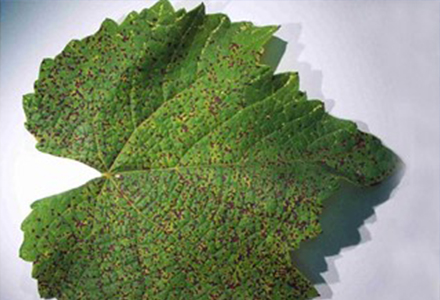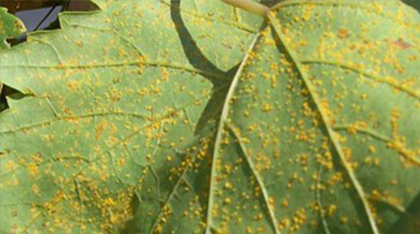PLANT PEST

Credit: Andrew M. Daly DPIFM, PaDIL
Grapevine leaf rust
Exotic to Australia
Features: Fungal disease of grape causing dark spots on the upper
surface of leaves.
Where it's from: Asia, North America, South America,
Timor-Leste, the Russian Federation.
How it spreads: Importation of infected vines or plant material
including leaves; local spread over long distances through trade
of infected plants or by spores blown in the wind; transported on
clothing, equipment and personal items.
Keep it out
Grapevine leaf rust is caused by the fungus Phakopsora euvitis and mainly occurs in warm temperate and subtropical grape growing regions. Grapevine leaf rust only infects grapes, usually affecting leaves but can also damage fruit and stems, resulting in damage to grape crops.
The rust spreads easily, with spores carried on the wind, or on equipment and clothing. Heavy infestations are common, particularly in warmer temperatures, often ruining the crop. Damage continues into the next season with fewer fruit formed.
The fungus was found in the Northern Territory in 2001 but it was eradicated by 2007.
It is crucial that the fungus is not re-introduced into Australia, where it could spread throughout our highly valued and valuable grape growing regions.
Importing goods
To keep grapevine leaf rust out of Australia, never ignore Australia’s strict biosecurity rules.
Import shipments may need to be treated and certified, so before you import, check our Biosecurity Import Conditions system (BICON).
Growers
- Only source high health status (preferably certified) plant material from reliable and accredited suppliers.
What to look for
Grapevine leaf rust is the only known rust on grapes. Look for:
- grapevines that are not looking healthy, or have poor yield
- small dark, angular spotting on the upper surface of grapevine leaves
- orange or yellow spots on the underside of leaves.

Importation of infested vines, leaves, or other plant material is the most likely way that grapevine leaf rust could make it to Australia.
Growers and home gardeners
Look for wilting and leaf symptoms—dark spots on the top, yellow spots underneath.
Grapevine leaf rust is the only rust disease that affects grapevines.
What to do
If you think you’ve found grapevine leaf rust:
- take a photo
- do not disturb infected plants (this may be as simple as closing the doors on a shipping container or preventing access to part of the vineyard).
Read the detail
- Plant Health Australia: grapevine leaf rust fact sheet
- NSW Department of Primary Industries: grapevine leaf rust
- Establish good vineyard biosecurity measures to protect your property. Everything you need to know is available from Farm Biosecurity
